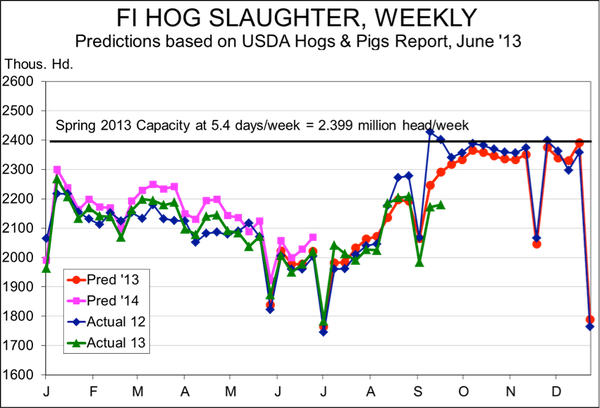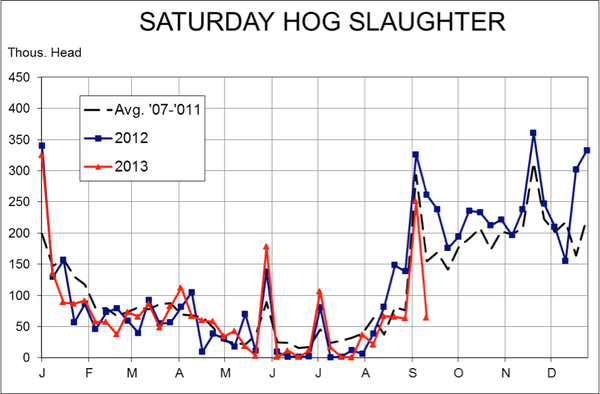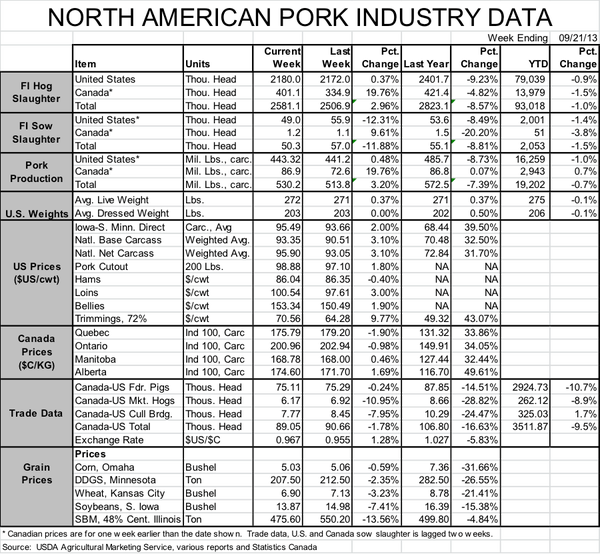Hog Slaughter Continues to Fall Short
September 23, 2013

Hog supply is still on everyone’s mind as weekly slaughter totals continue to run well below year-ago levels. I addressed this topic last week but I think it bears attention again this week.
As can be seen below, this is the fourth week of the last five in which slaughter has been FAR LOWER than one year ago. The last two weeks have seen runs 10.5% and 9.2% lower than in 2012. Last year, of course, producers were trying to move pigs to market to reduce feed costs. The result was significant increases in hog slaughter and lower – or at least not higher as normally is the case in September – market weights. So, the year-ago numbers are a high mark indeed for comparison.

But recent slaughter has been significantly lower than “expected” as well. In fact, slaughter figures the past three weeks have fallen short of my forecast numbers by 84,000, 73,000 and 111,000 head, respectively. Does this mean hog numbers in the June report are wrong? Not necessarily. Before Labor Day, actual slaughter had been within 0.1% of my forecasts, based on the June report and some adjustments for last year’s unusual conditions. It would be pretty unusual for a report to go from dead-on accurate to badly inaccurate in the course of a few weeks.
Three possibilities seem reasonable. First, hotter weather and the corn from the very, very bottom of everyone’s bins very likely slowed performance in August. The shortfalls in slaughter seem large even for this factor but we need to remember that we started using the 2012 corn crop early and have had to make it stretch late. The issues of late-season corn quality and palatability could be especially acute this year.
The second factor is, as was addressed last week, lousy packer margins. I have always equated the size of Saturday hog slaughter to packer margins. Saturday operations are critical in holiday-shortened weeks to keep hogs moving and keep product supplied to end users. But Saturday operations in non-holiday weeks are, for many packers, opportunities. If profits are good, they will add hours even when the labor for those hours costs time-and-a-half. And those opportunities usually grow past Labor Day when hog supplies are generally higher.
Lower Saturday hog slaughter
More hogs and the strong pork demand of fall usually mean good margins. Not this year, and the result is very low Saturday slaughter. As can be seen below, Saturday slaughter has been 33,000, 42,000, and 90,000 head lower than the average of the past five years in the most recent three weeks.

The third factor is that cash corn prices have plummeted, driving the cost of those last few pounds of gain (i.e. what we economists call “marginal costs”) lower at a time when hog prices have rallied. Omaha corn was reported at $6.45/bushel on Sept. 5. It was $5.03 last week. Producers have an incentive to take hogs heavier but weights have not responded much yet.
Numbers should grow
I still expect numbers to grow over the coming weeks. I expect packers will be able to lower their bids in coming weeks and thus grow margins. More hogs will still move to market in spite of those lower bids simply because there are seasonally more hogs that must move. But it will be difficult to catch up to my forecast levels quickly unless a significant number of hogs are backed up on farms.
Finally, Friday’s Cattle On Feed report indicates that cattle numbers and beef supplies will remain very tight in Q1 of 2014. August placements were the lowest on record for August at 1.788 million head, 10.9% lower than last year. Sept. 1 feedlot inventories were the lowest for September since 2003 and were 7.2% lower than last year. Lower beef supplies and resulting high beef prices have been a positive influence on pork demand all this year and it appears that influence will continue. Higher chicken numbers and lower chicken prices will, of course, have the opposite impact but the magnitude of the beef price strength and the recent re-positioning of pork (“Cook it Like a Steak”) have me hopeful that the positive impact will dominate. I believe we are, barring any big snafus, in for a good period for pork demand.


About the Author(s)
You May Also Like





